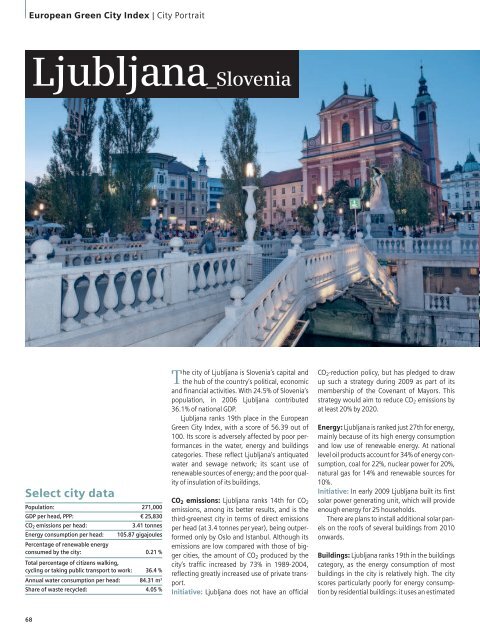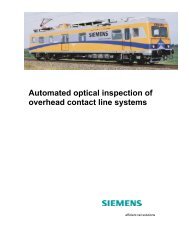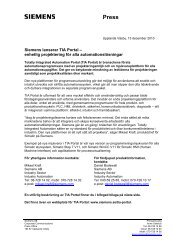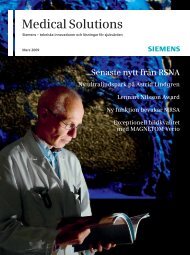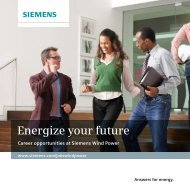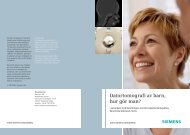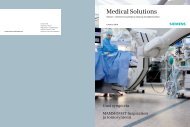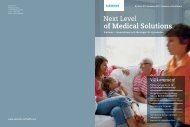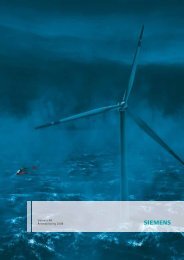European Green City Index - Siemens
European Green City Index - Siemens
European Green City Index - Siemens
Create successful ePaper yourself
Turn your PDF publications into a flip-book with our unique Google optimized e-Paper software.
<strong>European</strong> <strong>Green</strong> <strong>City</strong> <strong>Index</strong> | <strong>City</strong> Portrait<br />
Ljubljana_Slovenia<br />
Select city data<br />
Population: 271,000<br />
GDP per head, PPP: € 25,830<br />
CO2 emissions per head: 3.41 tonnes<br />
Energy consumption per head:<br />
Percentage of renewable energy<br />
105.87 gigajoules<br />
consumed by the city: 0.21 %<br />
Total percentage of citizens walking,<br />
cycling or taking public transport to work: 36.4 %<br />
Annual water consumption per head: 84.31 m3 Share of waste recycled: 4.05 %<br />
The city of Ljubljana is Slovenia’s capital and<br />
the hub of the country’s political, economic<br />
and financial activities. With 24.5% of Slovenia’s<br />
population, in 2006 Ljubljana contributed<br />
36.1% of national GDP.<br />
Ljubljana ranks 19th place in the <strong>European</strong><br />
<strong>Green</strong> <strong>City</strong> <strong>Index</strong>, with a score of 56.39 out of<br />
100. Its score is adversely affected by poor performances<br />
in the water, energy and buildings<br />
categories. These reflect Ljubljana’s antiquated<br />
water and sewage network; its scant use of<br />
renewable sources of energy; and the poor quality<br />
of insulation of its buildings.<br />
CO2 emissions: Ljubljana ranks 14th for CO2<br />
emissions, among its better results, and is the<br />
third-greenest city in terms of direct emissions<br />
per head (at 3.4 tonnes per year), being outperformed<br />
only by Oslo and Istanbul. Although its<br />
emissions are low compared with those of bigger<br />
cities, the amount of CO2 produced by the<br />
city’s traffic increased by 73% in 1989-2004,<br />
reflecting greatly increased use of private transport.<br />
Initiative: Ljubljana does not have an official<br />
CO2-reduction policy, but has pledged to draw<br />
up such a strategy during 2009 as part of its<br />
membership of the Covenant of Mayors. This<br />
strategy would aim to reduce CO2 emissions by<br />
at least 20% by 2020.<br />
Energy: Ljubljana is ranked just 27th for energy,<br />
mainly because of its high energy consumption<br />
and low use of renewable energy. At national<br />
level oil products account for 34% of energy consumption,<br />
coal for 22%, nuclear power for 20%,<br />
natural gas for 14% and renewable sources for<br />
10%.<br />
Initiative: In early 2009 Ljubljana built its first<br />
solar power generating unit, which will provide<br />
enough energy for 25 households.<br />
There are plans to install additional solar panels<br />
on the roofs of several buildings from 2010<br />
onwards.<br />
Buildings: Ljubljana ranks 19th in the buildings<br />
category, as the energy consumption of most<br />
buildings in the city is relatively high. The city<br />
scores particularly poorly for energy consumption<br />
by residential buildings: it uses an estimated<br />
1,653 megajoules per square metre per year,<br />
well above the index average of 909 megajoules.<br />
Ljubljana has no specific standards relating<br />
to the upgrading of older buildings, al -<br />
though efficiency standards do exist for new<br />
buildings.<br />
Initiative: The city hopes to reduce the use of<br />
energy in public buildings by 15% by 2013 compared<br />
with the level in 2004. It also plans to<br />
increase the availability of renewable energy<br />
sources in general.<br />
Transport: Ljubljana ranks in 13th place in the<br />
transport category. Although the city does relatively<br />
well in transport when compared to other<br />
categories, it is still set back to some degree by the<br />
relatively low usage of non-car transport. Although<br />
the city has a vast bus network, buses move<br />
slowly because of the general lack of dedicated<br />
bus lanes.<br />
As a consequence, the number of bus passengers<br />
has been decreasing steadily for the<br />
past 15 years, and commuters tend to use their<br />
own cars for reasons of speed and comfort.<br />
Initiative: In 2007 Ljubljana closed a large part<br />
of its city centre to traffic, and plans to introduce<br />
further pedestrian areas during 2009.<br />
Water: Ljubljana ranks 27th in the water category.<br />
This is mainly owing to poor scores for<br />
water system leakages and the proportion of<br />
dwellings connected to the sewage system, as<br />
the city’s per-head water consumption level is<br />
below the average (at 84 cubic metres per year,<br />
compared with a 30-city average of 105 cubic<br />
metres).<br />
Initiative: The city authorities are planning a<br />
further increase in the number of wastewater<br />
connections in the next few years, along with<br />
repairs to the existing system in order to improve<br />
the water supply and reduce pollution.<br />
Waste and land use: Ljubljana is ranked 18th<br />
in the waste and land use category, bolstered by<br />
a strong score for municipal waste production,<br />
where it comes joint sixth overall. The city’s<br />
inhabitants produce about 441 kg of waste per<br />
year, well below the 30-city average of 511 kg.<br />
However, Ljubljana performs poorly on recycling,<br />
which pulls down its overall score. A new<br />
waste-management site, to help to raise the<br />
share of recycled waste, is currently being built.<br />
Initiative: Ljubljana introduced a lottery in late<br />
2008 to encourage recycling. It involves a fortnightly<br />
draw in which a household or office<br />
recycling bin is randomly selected, with a cash<br />
prize awarded if it contains the correct type of<br />
waste.<br />
Air quality: Ljubljana ranks 14th for air quality.<br />
It performs particularly well on sulphur dioxide<br />
emissions, with lower levels than many larger,<br />
wealthier cities.<br />
So far Ljubljana has been unsuccessful in<br />
reducing traffic volumes in the city centre, and<br />
this contributes to high volumes of particulate<br />
matter, although overall pollution levels are<br />
about average.<br />
Initiative: The opening of the Sentvid tunnel in<br />
2008 has made it possible for motorists driving<br />
from the seaside to the north of Slovenia to<br />
bypass Ljubljana, thus reducing traffic and related<br />
air pollution.<br />
Environmental governance: Ljubljana ranks<br />
joint 15th with London in the environmental<br />
governance category, mainly thanks to a high<br />
score in the green management subcategory.<br />
Over the past decade Ljubljana has paid ever<br />
more attention to green policies, and has recently<br />
suggested plans to design a sustainable energy<br />
action plan and to set a target for the reduction<br />
of CO2 emissions, as well as subscribing to<br />
the Covenant of Mayors.<br />
Environmental governance Energy<br />
6<br />
68 69<br />
Air Quality<br />
CO2<br />
10<br />
8<br />
4<br />
2<br />
0<br />
Buildings<br />
Waste and Land Use Transport<br />
Water<br />
Cycle sightseeing<br />
Ljubljana<br />
Best<br />
Average<br />
From April to October, the main cycling season<br />
in Ljubljana, there are 80 bicycles available<br />
to the public for hire from eight locations<br />
in the city centre. Charges are €1 for<br />
two hours or €5 for a day, but hire is free of<br />
charge for anyone with a Ljubljana tourist<br />
card. The scheme is targeted primarily at<br />
tourists rather than local residents. Accordingly,<br />
most of the bicycles are rented during<br />
the peak tourist season from July to August.<br />
As an indication of the popularity of the<br />
scheme, at one location bicycles were hired<br />
out more than 400 times for two-hour periods<br />
in July alone, and around one-half of that<br />
number were used for full-day rental. The city<br />
authorities are planning to increase the network<br />
of locations and the number of bicycles<br />
in the scheme.


